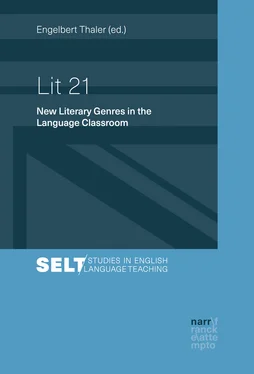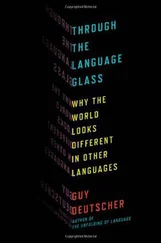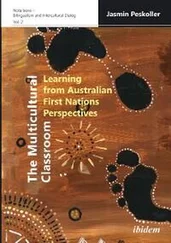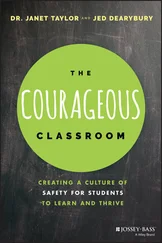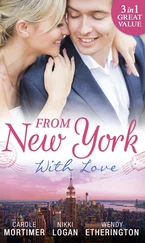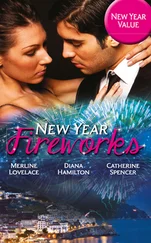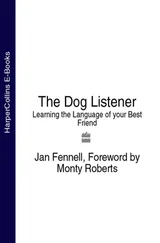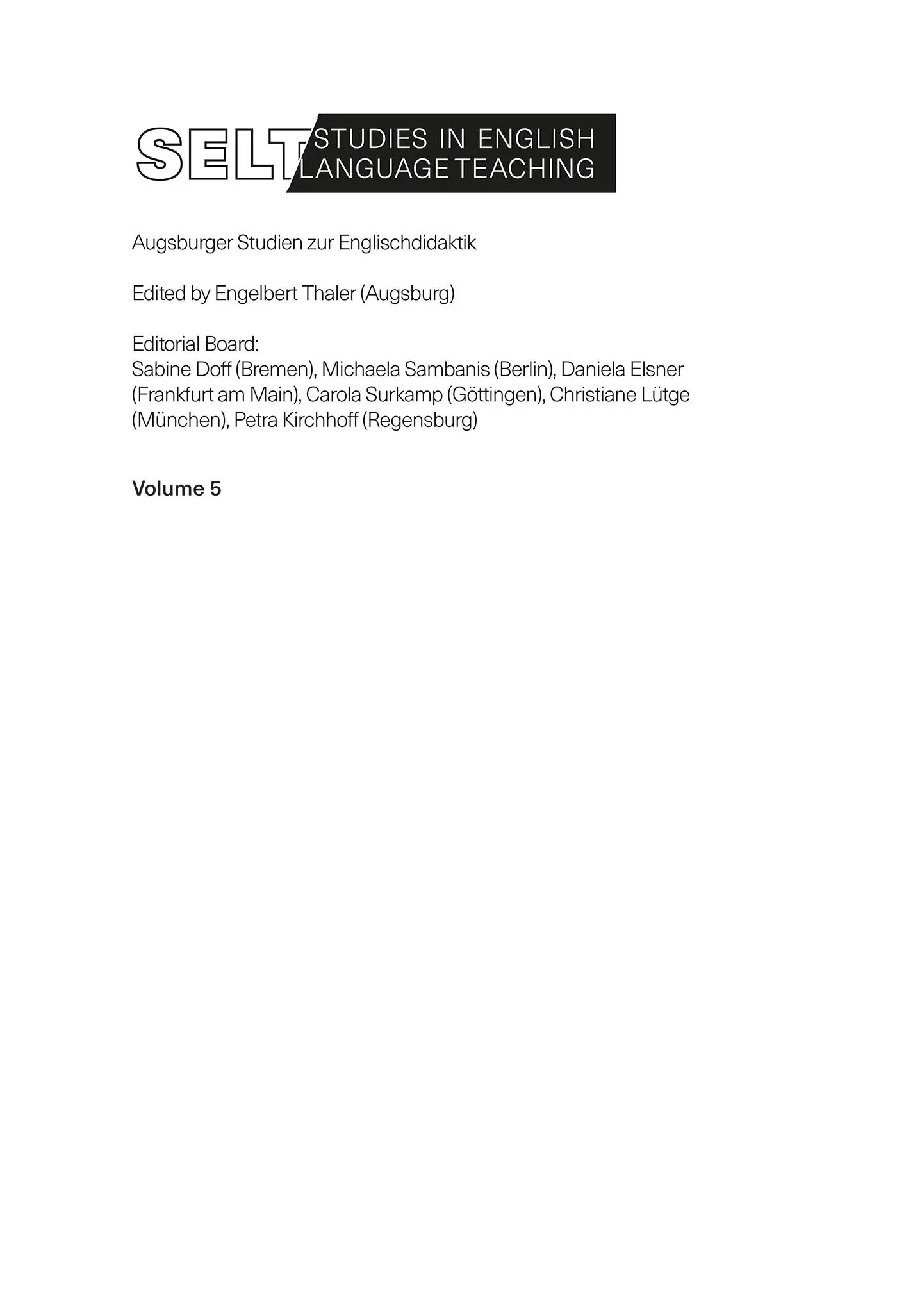
Engelbert Thaler
Lit 21 - New Literary Genres in the Language Classroom
Narr Francke Attempto Verlag Tübingen
[bad img format]
© 2019 • Narr Francke Attempto Verlag GmbH + Co. KG
Dischingerweg 5 • D-72070 Tübingen
www.narr.de• info@narr.de
Das Werk einschließlich aller seiner Teile ist urheberrechtlich geschützt. Jede Verwertung außerhalb der engen Grenzen des Urheberrechtsgesetzes ist ohne Zustimmung des Verlages unzulässig und strafbar. Das gilt insbesondere für Vervielfältigungen, Übersetzungen, Mikroverfilmungen und die Einspeicherung und Verarbeitung in elektronischen Systemen.
ISBN 978-3-8233-8307-9 (Print)
ISBN 978-3-8233-0171-4 (ePub)
Panta rhei. The world is in motion. So is literary production. The “Big 5 -ation waves”, i.e. globalization, digitalization, visualization, diversification, and multi-optionalization, are rocking the literary boat by adapting traditional genres, spawning new text types and modifying demands put on contemporary readers. New literary genres like visual literature, transcultural imaginaries, crunch lit, doodle fiction, fanfic, clifi, cosmopolitan novels, text-talk fiction, email novels, twitterature and digi fiction are gaining ground, and should be evaluated as regards their foreign language learning potential.
For all these reasons, this book is dedicated to the use of Lit 21 in TEFL. As all edited volumes in the SELT (Studies in English Language Teaching) series, it follows a triple aim:
1 Linking TEFL with related academic disciplines
2 Balancing TEFL research and classroom practice
3 Combining theory, methodology and exemplary lessons
This triple aim is reflected in the three-part structureof this volume. In Part A (Theory), the topic of Lit 21 is investigated from the perspectives of three academic disciplines, i.e. from the viewpoints of TEFL, literary studies and media studies. Part B (Methodology) assembles four contributions on selected genres, media and techniques. Six concrete lesson plans can be found in Part C (Classroom). These lessons were designed by lecturer (editor) and students at university, then conducted and assessed by teachers at German schools, and finally revised by the editor. Each of these chapters is divided into genre (brief background information on the new text type), sample texts, procedure (source, synopsis, competences, topics, level, time, phases of the lesson), materials (texts, worksheets, board sketches), solutions (expected answers), and bibliography.
Part Ais introduced by the TEFL perspective. Engelbert Thaleradopts a five-step approach to examining the didactic potential of post-millennial fiction in the language classroom: What is the 21st century like? Who are the 21st century readers? What are the features of 21st century literature? What new literary genres can be identified in the 21st century? How should you teach these genres in the 21st century language classroom?
The perspective of literary studiesis adopted by Ansgar Nünning. First, his essay accounts for the cultural dynamics of generic change by providing a brief look at some salient contexts and new concerns which serve as catalysts for the transformations of new genres of Lit 21. Second, it gives a selective overview of some emerging genres and new trends in 21st-century British novels, including hybridization, ‘fictions of the Internet’ and the rise of fragmentary essay-novels. Third, the author proposes some reasons why reading and teaching contemporary fiction matter in an age dominated by digital and social media.
Thomas Strasseradopts the perspective of media studies. He investigates the potentials of digital storytelling and tag cloud applications in a blended learning context focussing on productive and receptive skills in the EFL literature classroom. His findings show that certain educational applications, which consider various dimensions of the teaching of literature, elicit motivating phases of L2-acquisition among the learners.
Part Bis introduced by Frauke Matz. She makes students realize the ‘terrors’ of the 21st century by recommending dystopian narratives, as they offer fictional insights into global discourses and serve as suitable texts when pursuing global education. Her article informs us about the genre and its current developments as well as discusses ways of fostering critical thinking skills, global attitudes and democratic participation within the context of global education.
Katrin Thomsonis convinced that text-talk fiction, which attracts especially a young adult readership, offers great, yet still mostly untapped potential for the EFL literature classroom. She explores the characteristic features of this genre, discusses the didactic and methodological implications of reading text-talk narratives in the foreign language classroom, and presents a series of specific classroom activities.
Sophia Finck von Finckensteinexplains the Netflix effect and the narrative power of series 21 by turning to the political drama series House of Cards . Taking one of the first Netflix originals as an example, she demonstrates how to foster media literacy, political learning and literary competence (via allusions to Shakespeare tragedies) in advanced TEFL classes.
Claudia Deetjenuses comics journalismto help learners engage critically with the multi-modal ways of making meaning. When dealing with the graphic report of a Syrian refugee family or the account of Hurricane Katrina, learners may acquire multiple literacies, develop skills in selecting relevant information and critically assess multi-modal texts in terms of their constructedness.
Part Ccomprises six contributions, which demonstrate how new literary genres can be made use of in the English language classroom:
Shorties, to put it tautologically, are ideal texts for TEFL because they are short and narrative. Among the wealth of Shorties, also called flash fiction, skinny fiction, prosetry, short short story, or mini-fiction, we also find the sub-genre of drabbles, which consist of exactly 100 words. Valentina Kleinert has teenagers reflect on everyday life, stress, making ends meet, nature, and yearning for peace by reading a drabble titled What might not Happen.
Cherelle Hobson encourages learners to discuss similarities and differences between growing up in an Islamic and a Western culture by reading Persepolis . This autobiographical graphic memoir by Marjane Satrapi deals with her childhood and coming of age within a loving family living in Tehran during the Islamic Revolution and Iran-Iraq War.
Isabel Mair is convinced that digital picture books are among the most exciting innovations in literature for children in a long time. That is why she familiarizes us with the International Children’s Digital Library (ICDL), which makes children’s books from all over the world accessible, online and free of charge. To pave the way for the introduction of the ICDL in elementary TEFL classrooms, she suggests a lesson on The Jungle School .
Maximilian Leoson and Julian Schafroth are fans of fanfiction, i.e. a fan’s interpretation of a well-known text of popular culture, which leads to the creation of a narrative text produced by this fan. They intend to make learners become fans of Game of Thrones and write their own pieces of fanfiction.
Читать дальше
